Feasibility, Design, and Deployment Requirements of TCR for Bistatic SAR Radiometric Calibration
Abstract
:1. Introduction
2. Requirements of Calibration Target for Radiometric Calibration
2.1. The Beamwidth Requirement
2.2. The Stability of RCS Requirement
2.3. The SCR Requirement
3. Bistatic RCS Characteristics
3.1. Monostatic Bistatic Equivalence Theorem
3.2. FEKO Electromagnetic Simulation
4. Error Factors of TCR RCS
4.1. Interplate Orthogonality
4.2. Machining Error of Length
4.3. Pointing Deviation
4.4. Thermal Deformation
5. Simulation Experiments
6. Discussion
7. Conclusions
Author Contributions
Funding
Acknowledgments
Conflicts of Interest
References
- Gray, A.L.; Vachon, P.W.; Livingstone, C.E.; Lukowski, T.I. Synthetic aperture radar calibration using reference reflectors. IEEE Trans. Geosci. Remote Sens. 1990, 28, 374–383. [Google Scholar] [CrossRef]
- Ulander, L.M.H. Accuracy of using point targets for SAR calibration. IEEE Trans. Aerosp. Electron. Syst. 1991, 27, 139–148. [Google Scholar] [CrossRef]
- El-Darymli, K.; Mcguire, P.; Gill, E.; Power, D.; Moloney, C. Understanding the significance of radiometric calibration for synthetic aperture radar imagery. In Proceedings of the Electrical and Computer Engineering, Toronto, ON, Canada, 4–7 May 2014; Volume 2014, pp. 1–6. [Google Scholar]
- Burkholder, R.J.; Gupta, L.J.; Johnson, J.T. Comparison of monostatic and bistatic radar images. IEEE Antennas Propag. Mag. 2003, 45, 41–50. [Google Scholar] [CrossRef]
- Eigel, R.L.J.; Collins, P.J.; Terzuoli, A.J.; Nesti, G. Bistatic scattering characterization of complex objects. IEEE Trans. Geosci. Remote Sens. 2000, 38, 2078–2092. [Google Scholar] [CrossRef]
- Bezousek, P.; Schejbal, V. Bistatic and Multistatic Radar Systems. Radioengineering 2008, 17, 53–59. [Google Scholar]
- Pienaar, M.; Odendaal, J.W.; Joubert, J.; Cilliers, J.E.; Smit, J.C. Active calibration target for bistatic radar cross-section measurements. Radio Sci. 2016, 51, 515–523. [Google Scholar] [CrossRef] [Green Version]
- Dubois-Fernandez, P.; Cantalloube, H.; Vaizan, B.; Krieger, G.; Horn, R.; Wendler, M.; Giroux, V. ONERA-DLR bistatic SAR campaign: Planning, data acquisition, and first analysis of bistatic scattering behaviour of natural and urban targets. IEE Proc. Radar Sonar Navig. 2004, 153, 214–223. [Google Scholar] [CrossRef]
- Wang, W.Q. Inflight Antenna Pattern Measurement for Bistatic Synthetic Aperture Radar Systems. IEEE Antennas Wirel. Lett. 2007, 6, 432–435. [Google Scholar] [CrossRef]
- Monzon, C. A cross-polarized bistatic calibration device for RCS measurements. IEEE Trans. Antennas Propag. 2003, 51, 833–839. [Google Scholar] [CrossRef]
- Bradley, C.J.; Collins, P.J.; Fortuny-Guasch, J.; Hastriter, M.L.; Nesti, G.; Terzuoli, A.J.; Wilson, K.S. An investigation of bistatic calibration objects. IEEE Trans. Geosci. Remote Sens. 2005, 43, 2185–2191. [Google Scholar] [CrossRef]
- Balke, J. Field test of bistatic forward-looking synthetic aperture radar. In Proceedings of the 2005 IEEE International Radar Conference, Arlington, VA, USA, 9–12 May 2005; Volume 2005, pp. 424–429. [Google Scholar]
- Freeman, A. SAR calibration: An overview. IEEE Trans. Geosci. Remote Sens. 1992, 30, 1107–1121. [Google Scholar] [CrossRef]
- Massonnet, D. Capabilities and limitations of the interferometric cartwheel. IEEE Trans. Geosci. Remote Sens. 2001, 39, 506–520. [Google Scholar] [CrossRef]
- Yocky, D.A.; Wahl, D.E.; Jakowatz, C.V. Bistatic SAR: Imagery & Image Products; SAND2014-18346; Sandia National Laboratories: Albuquerque, NM, USA, 2014. [Google Scholar]
- D’Errico, M. Distributed Space Missions for Earth System Monitoring; Springer: New York, NY, USA, 2013. [Google Scholar]
- Rodriguez-Cassola, M.; Prats, P.; Schulze, D.; Tous-Ramon, N.; Steinbrecher, U.; Marotti, L.; Nannini, M.; Younis, M.; Lopez-Dekker, P.; Zink, M.; et al. First bistatic spaceborne SAR experiments with TanDEM-X. IEEE Geosci. Remote Sens. Lett. 2012, 9, 33–37. [Google Scholar] [CrossRef] [Green Version]
- Lavalle, M.; Pottier, E.; Ainsworth, T.; Solimini, D.; Rosich, B. Calibration of Dual Polarimetric C-Band SAR Data: A Possible Approach for SENTINEL-1. In Proceedings of the Fourth International Workshop on Science and Applications of SAR Polarimetry and Polarimetric Interferometry (PoIInSAR 2009), Frascati, Italy, 26–30 January 2009; Volume 668. [Google Scholar]
- Krishna, R.R.; Krishna, R.M.; Krishna, R.G.; Sekhar, D. Radar Cross Section Prediction for Different Objects Using MATLAB and Radar Cross Section (RCS) Reduction. Int. J. Adv. Res. Comput. Sci. Electron. Eng. 2012, 1, 67–75. [Google Scholar]
- Skolnik, M.I. Radar Handbook; McGraw-Hill: New York, NY, USA, 1970. [Google Scholar]
- Blacksmith, P.J.; Hiatt, R.E.; Mack, R.B. Introduction to radar cross-section measurements. Proc. IEEE 1965, 53, 901–920. [Google Scholar] [CrossRef]
- Cost, S.T. Measurements of the Bistatic Echo Area of Terrain at X-Band. Ph.D. Thesis, The Ohio State University, Columbus, OH, USA, 1965. [Google Scholar]
- Garthwaite, M. On the Design of Radar Corner Reflectors for Deformation Monitoring in Multi-Frequency InSAR. Remote Sens. 2017, 9, 648. [Google Scholar] [CrossRef]
- Kell, R.E. On the derivation of bistatic RCS from monostatic measurements. Proc. IEEE 2005, 53, 983–988. [Google Scholar] [CrossRef]
- Brock, B.C.; Doerry, A.W. Radar Cross Section of Triangular Trihedral Reflector with Extended Bottom Plate; SAND2009-2993; Sandia National Laboratories: Albuquerque, NM, USA, 2009. [Google Scholar]
- Zajc, T.; Thibeault, M.; Azcueta, M.; Ferreyra, J. A Precise Corner Reflector Characterization Technique; Ministry of Science, Technology and Productive Innovation: Caba, Argentina, 2017.
- Craeye, C.; Sobieski, P.; Robin, E.; Guissard, A. Angular errors in trihedrals used for radar calibrations. Int. J. Remote Sens. 1997, 18, 2683–2689. [Google Scholar] [CrossRef]
- Cumming, I.G.; Wong, F.G. Digital Processing of Synthetic Aperture Radar Data; Artech House: Norwood, MA, USA, 2005. [Google Scholar]
- Ender, J. A step to bistatic SAR processing. In Proceedings of the EUSAR, Ulm, Germany, 25–27 May 2004; pp. 356–359. [Google Scholar]
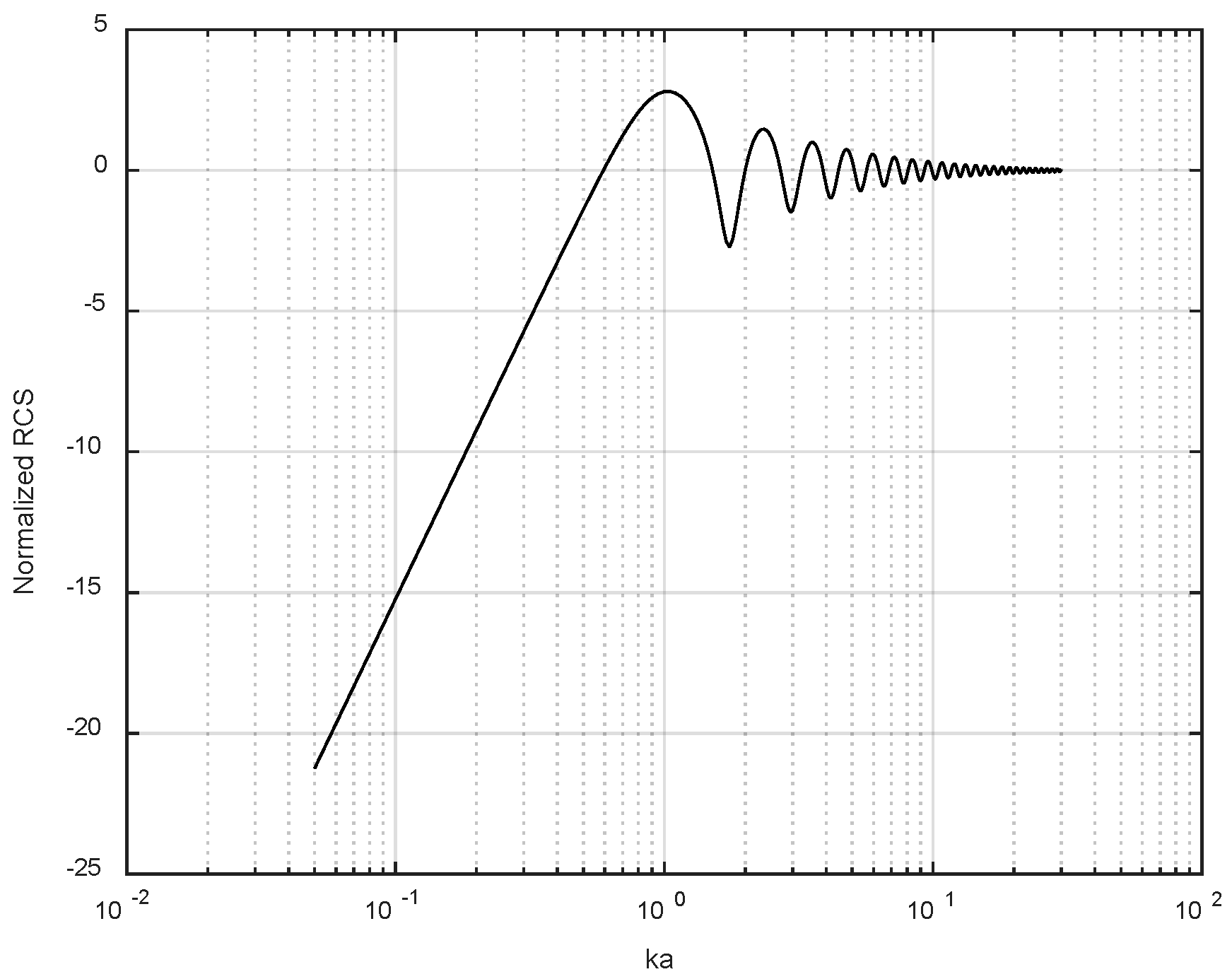
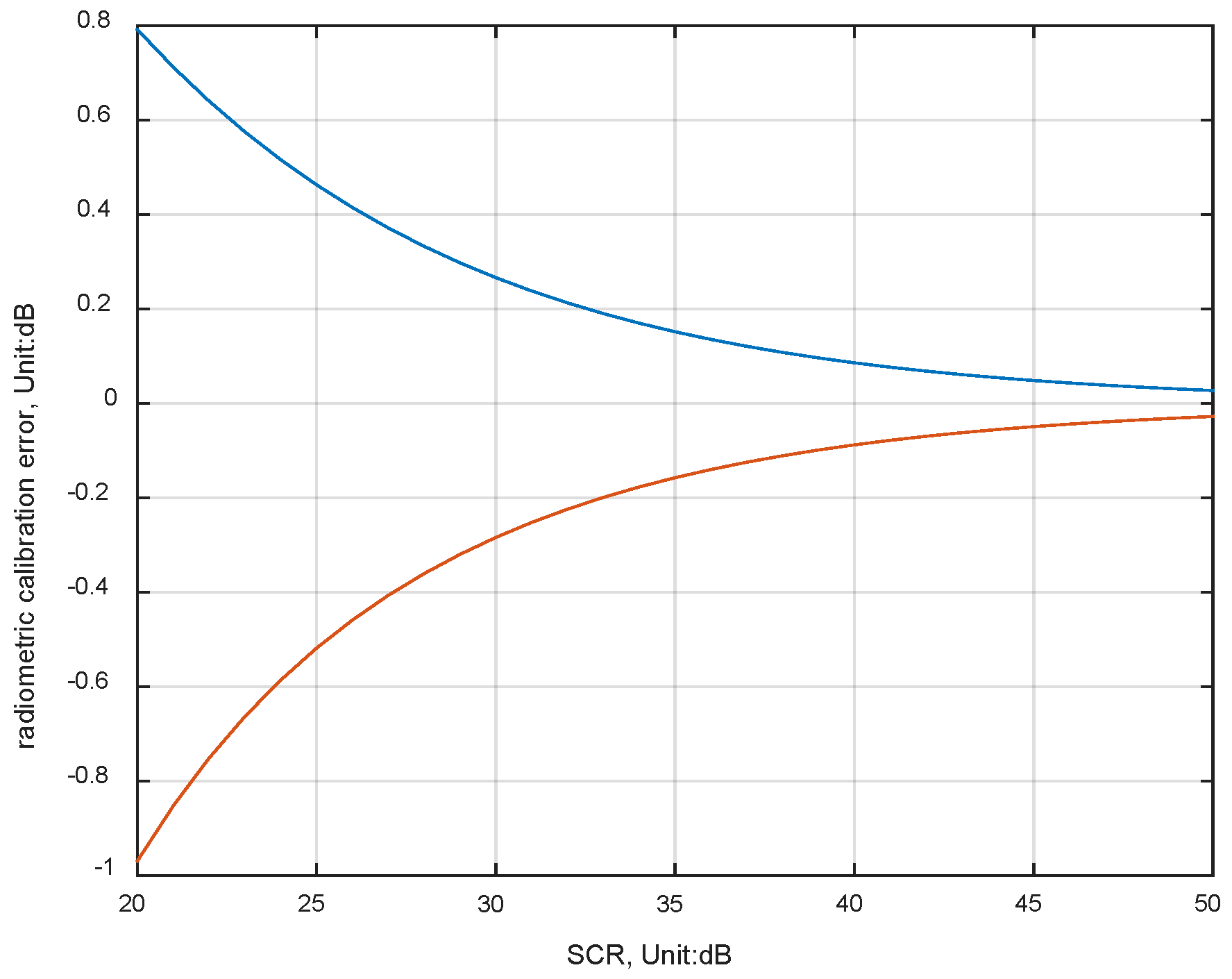
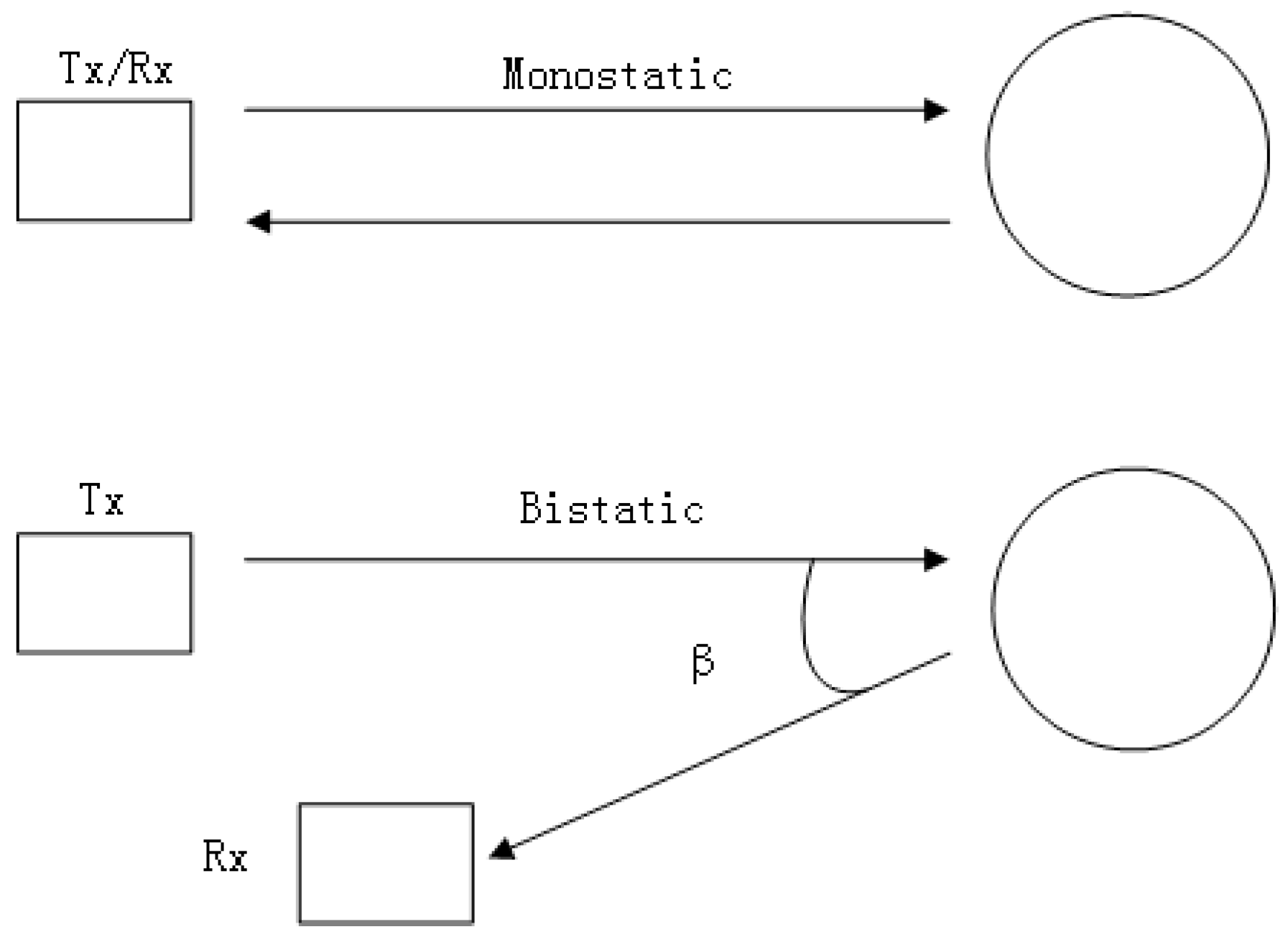
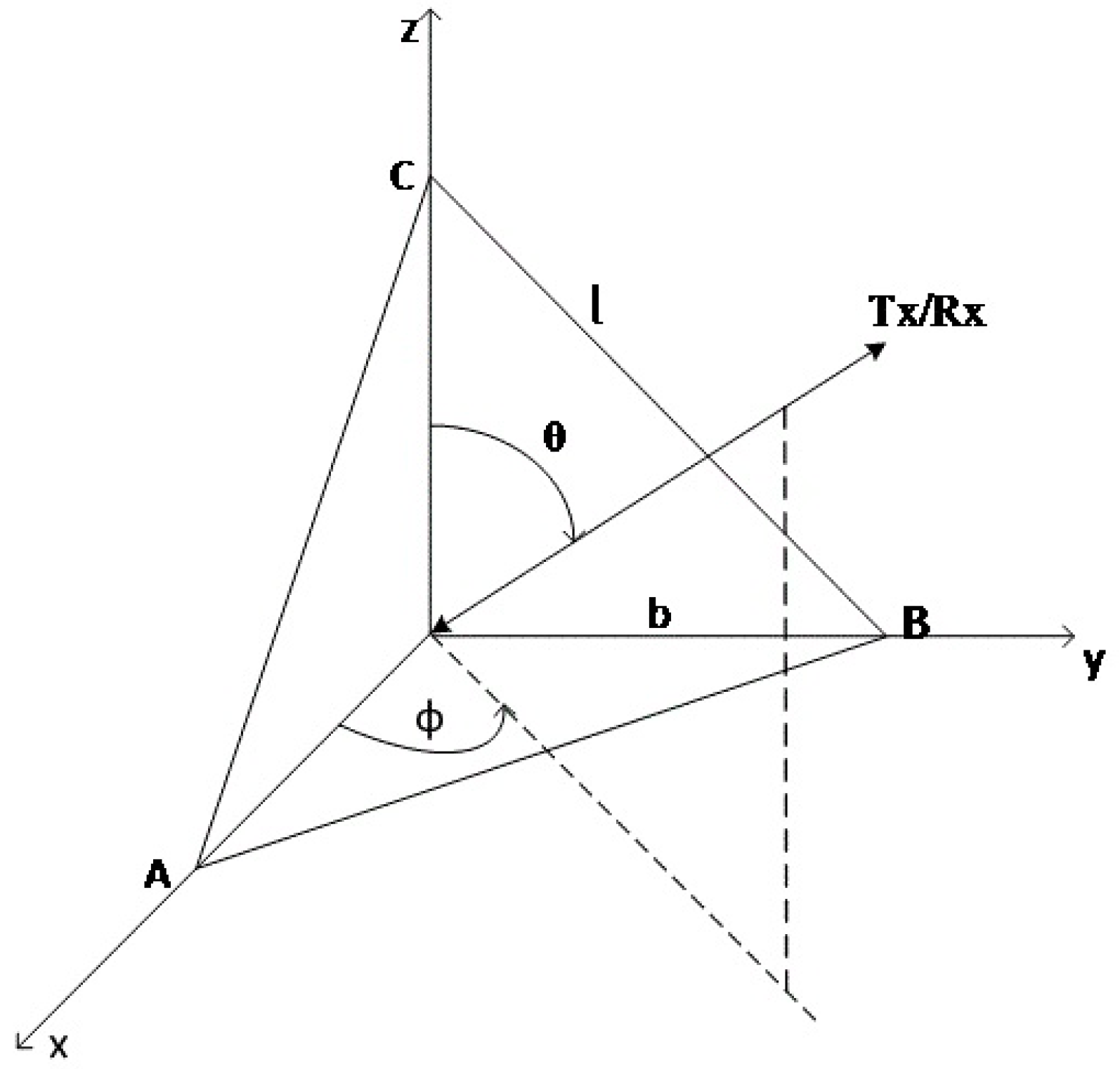



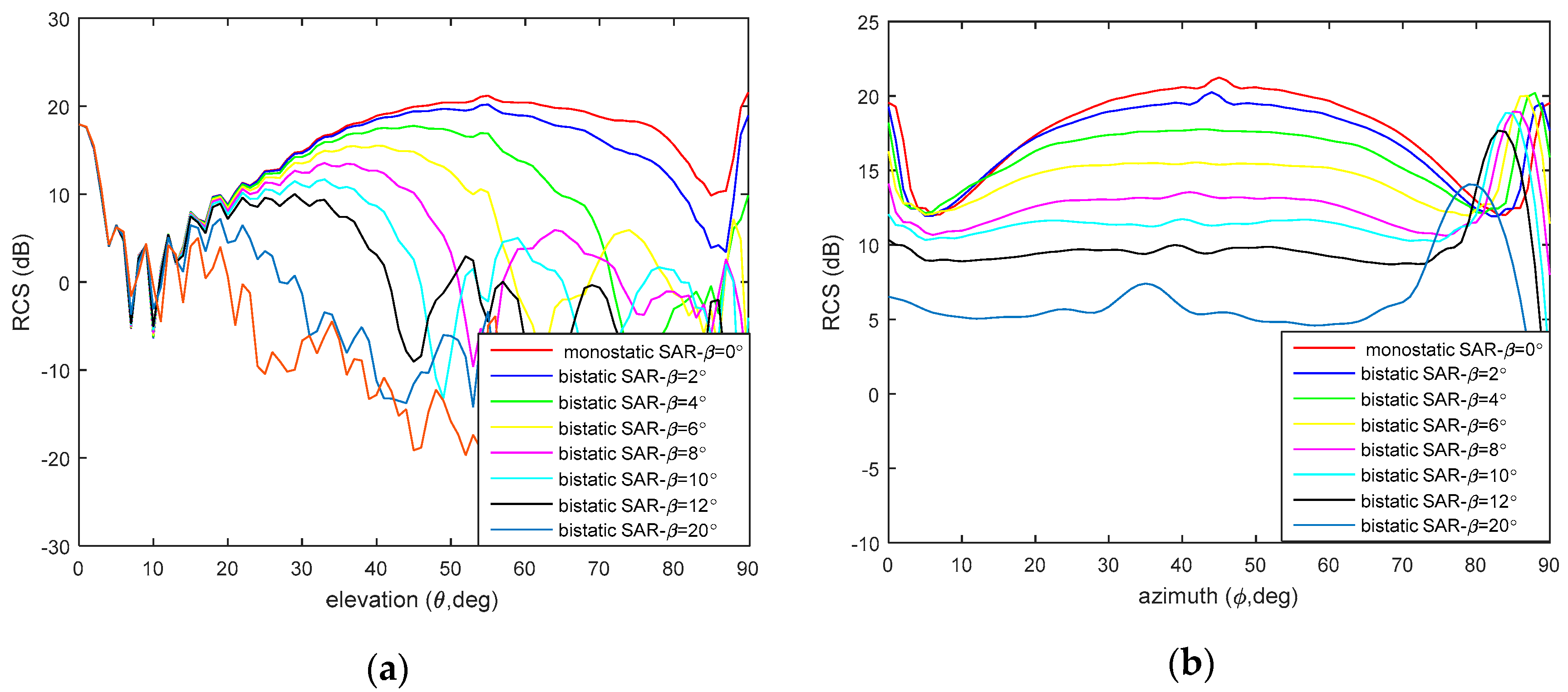
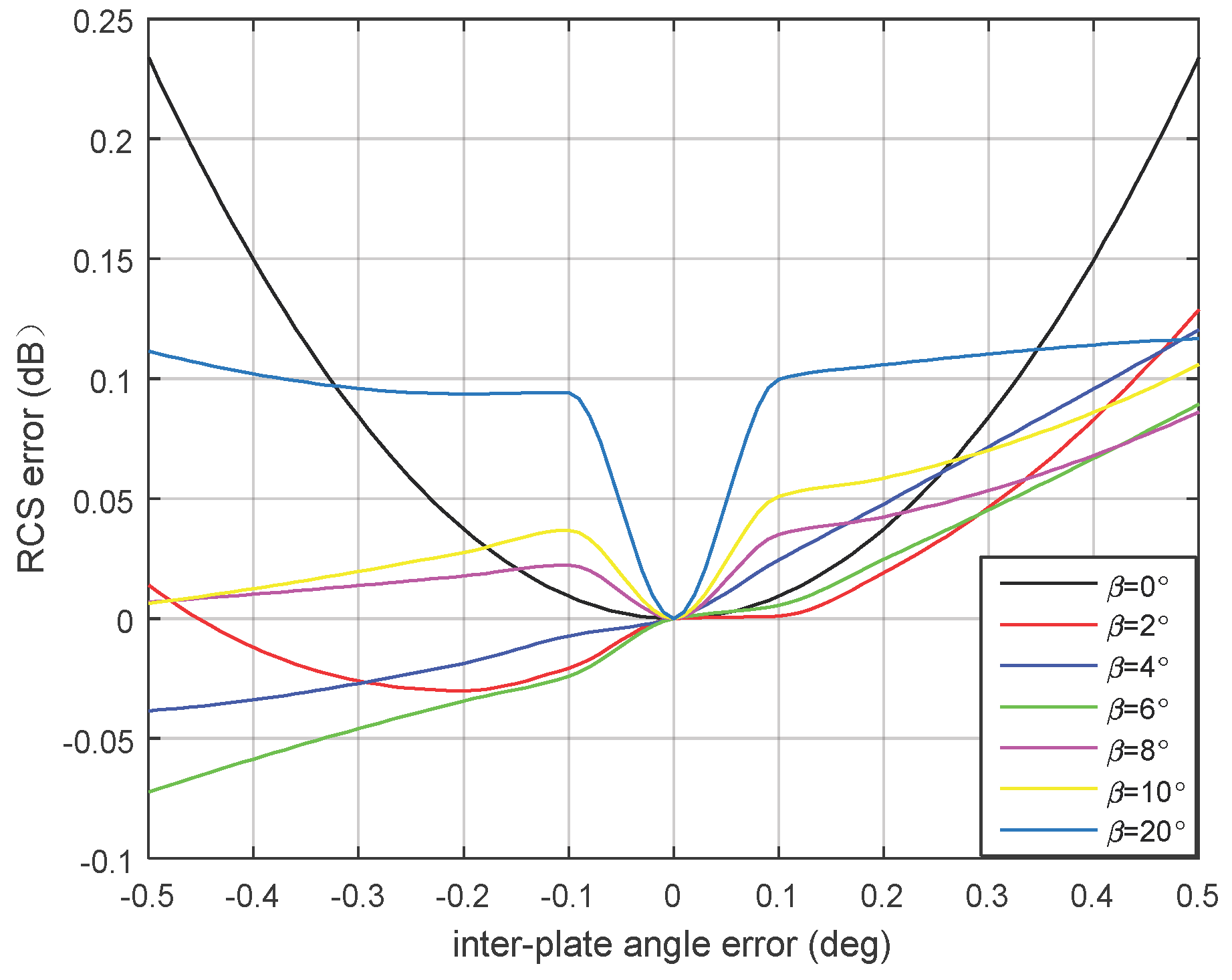

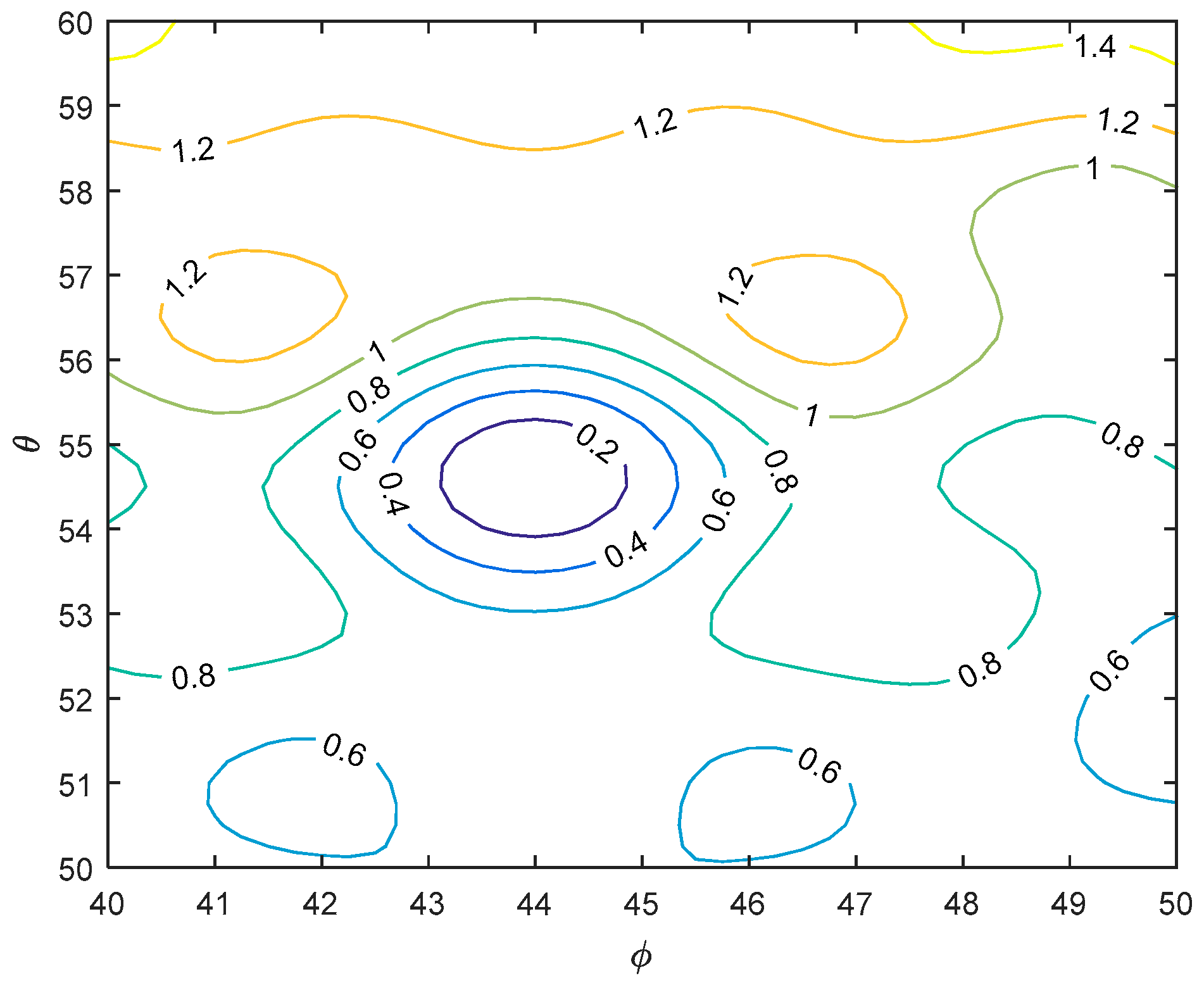
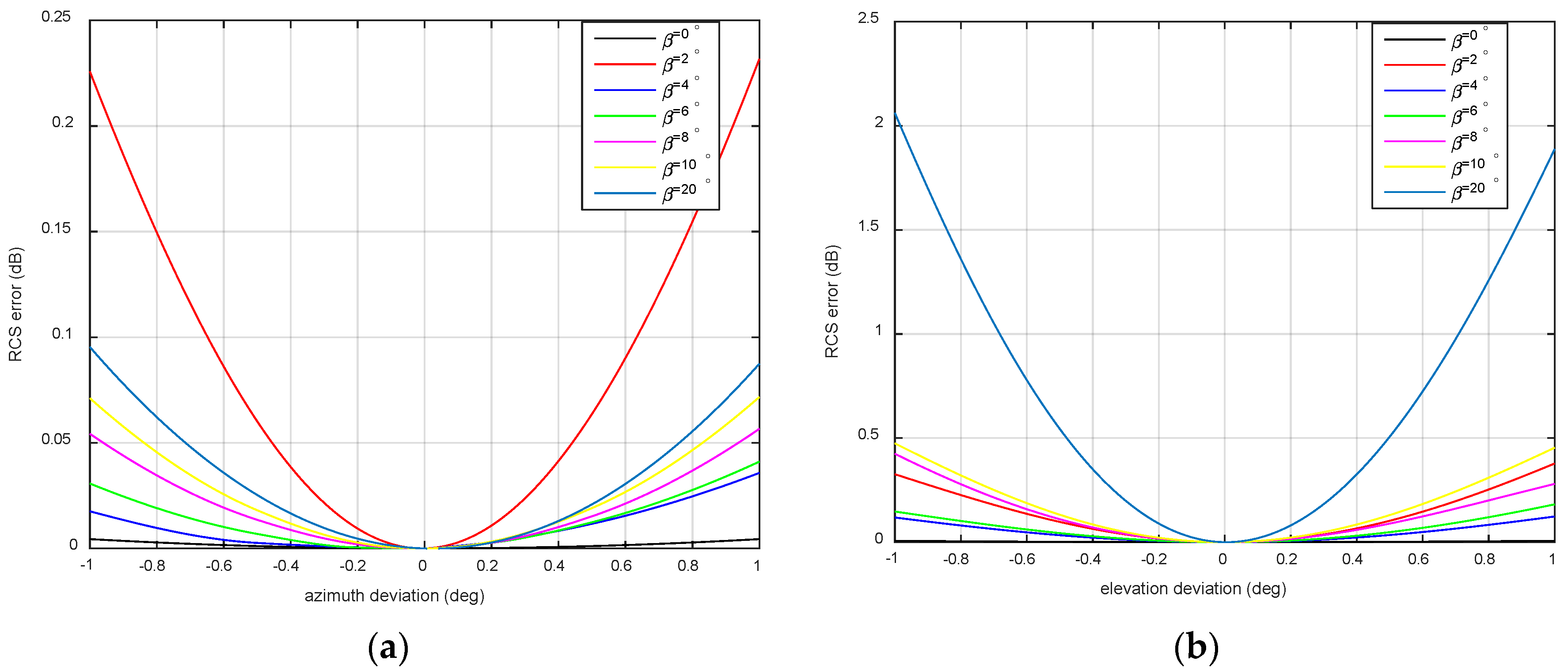

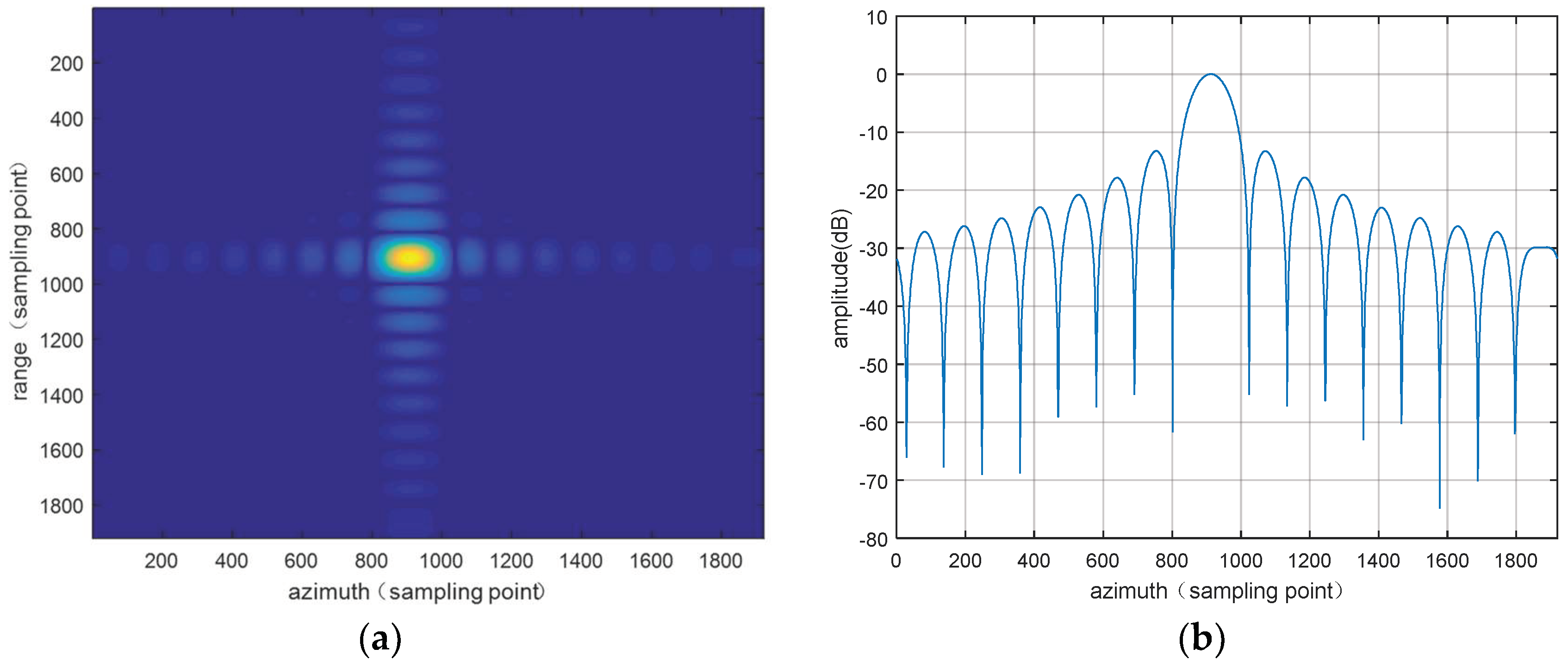
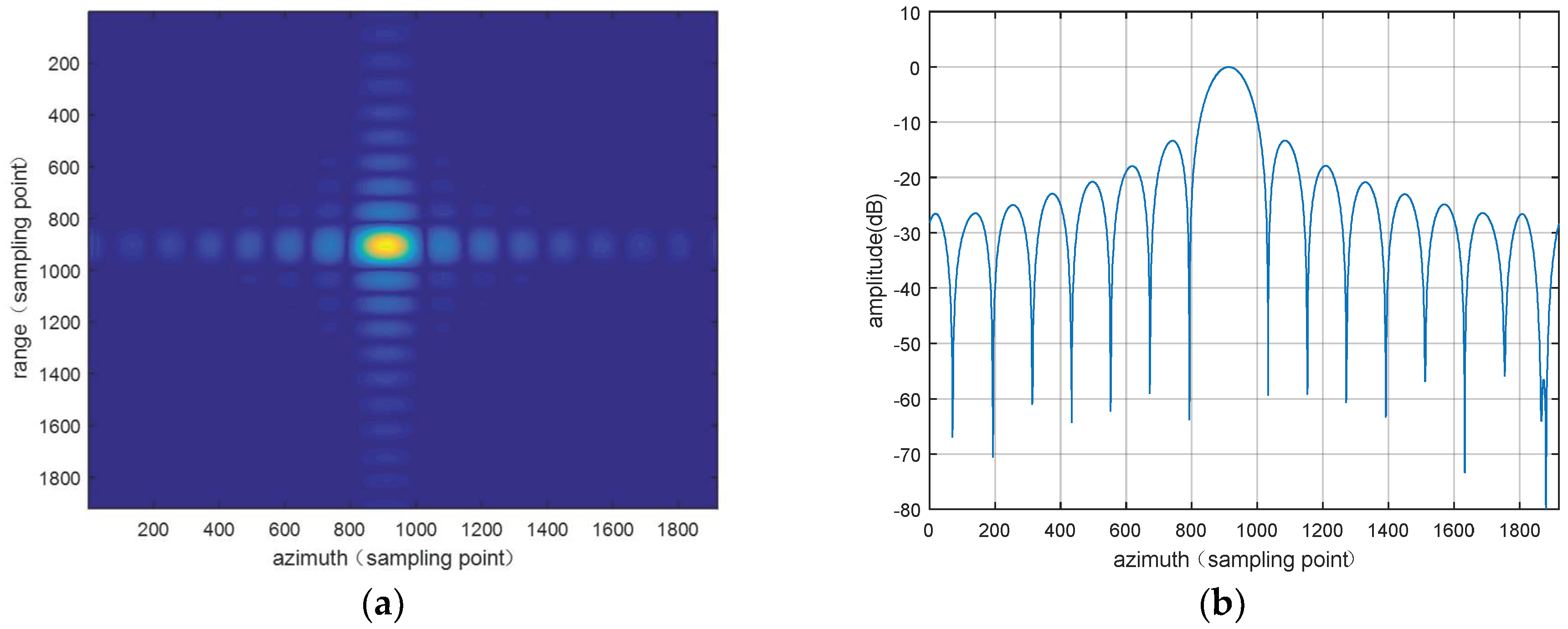
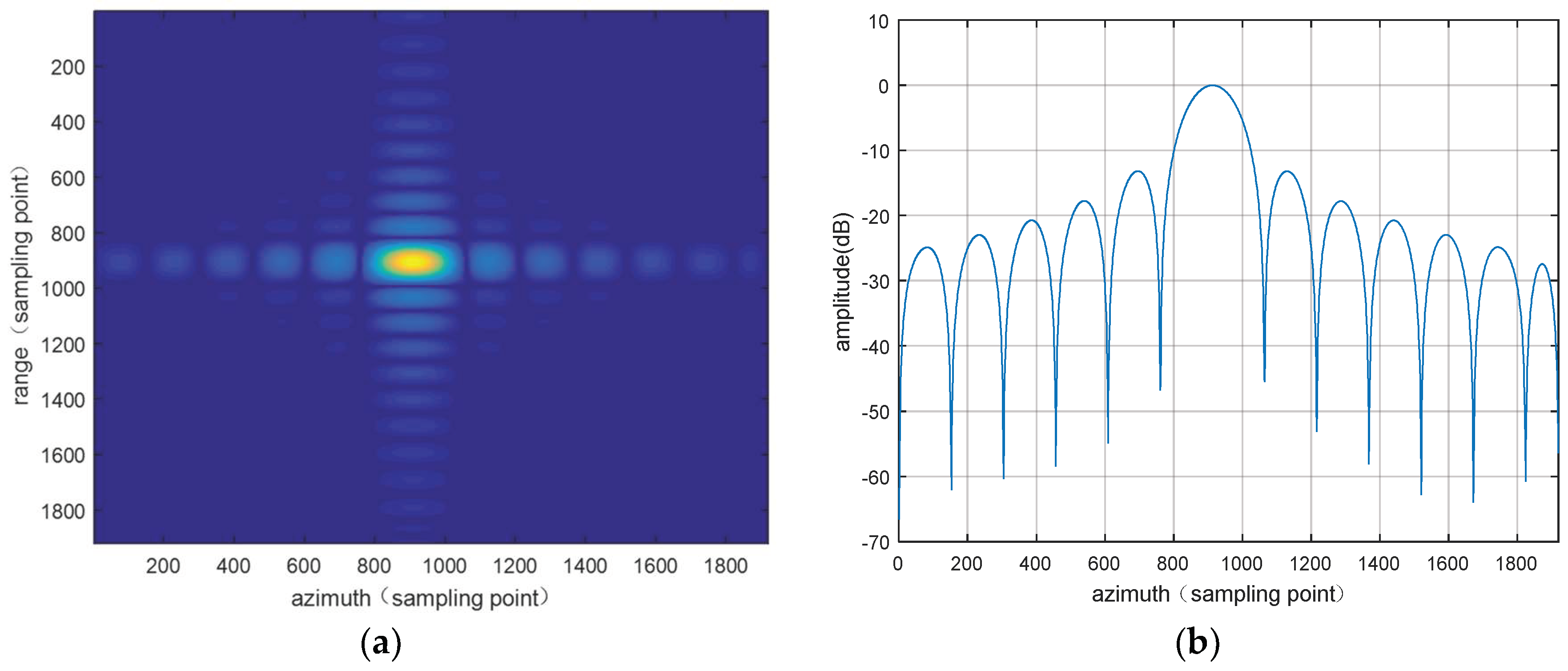
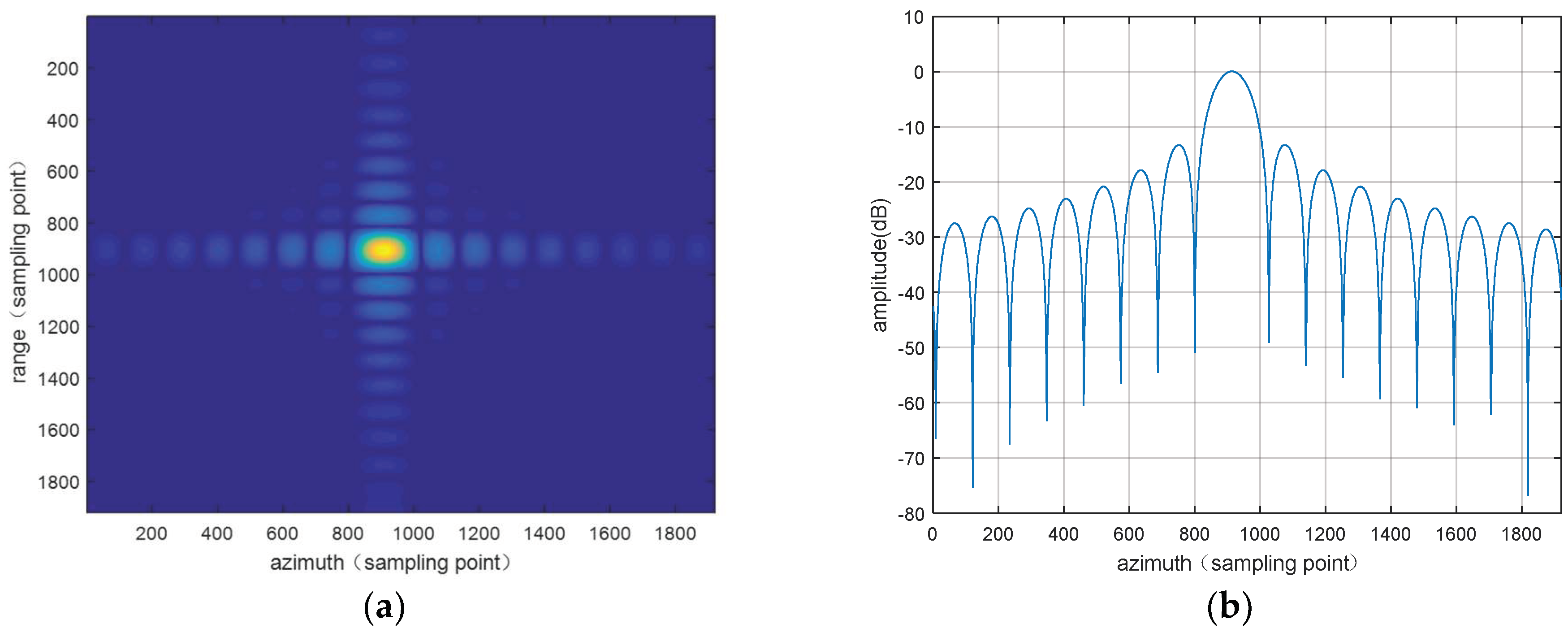
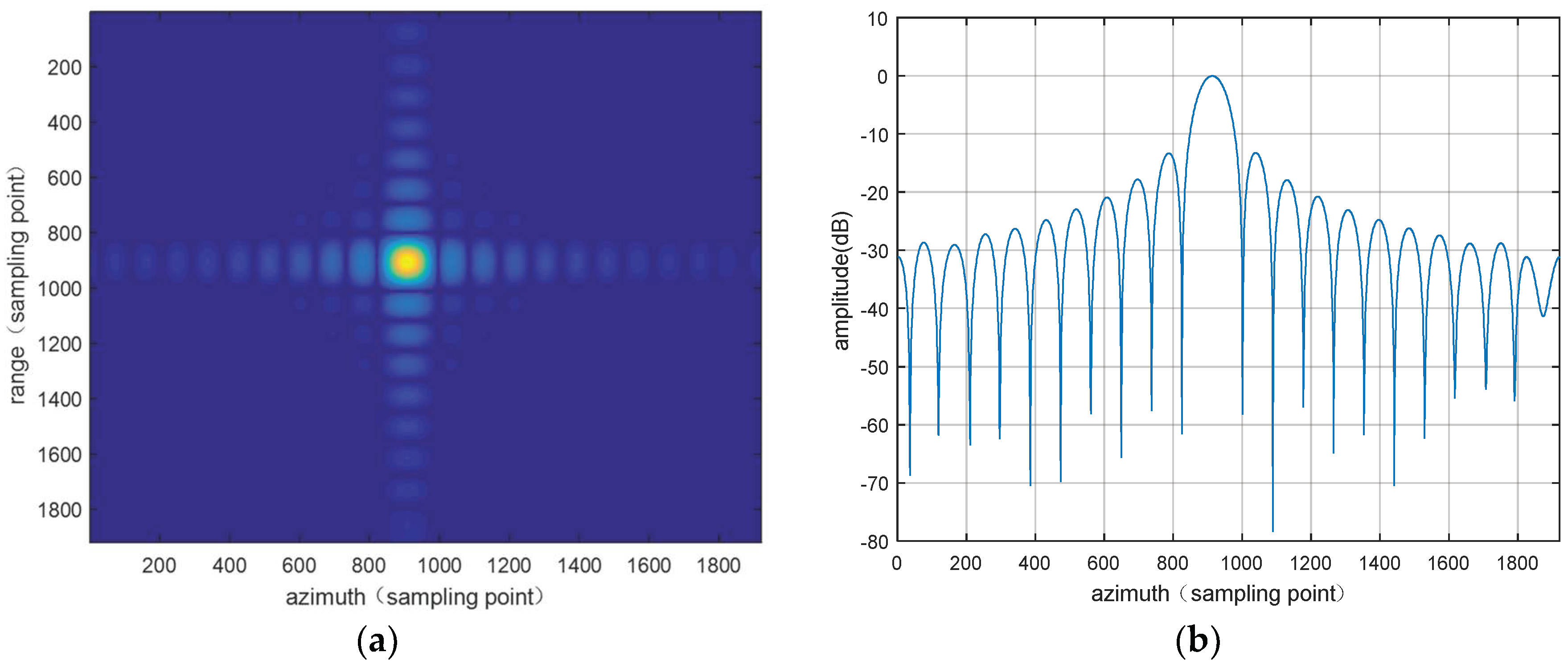

| Simulation Data Parameters | |
|---|---|
| Frequency | 9.6 GHz (X-Band) |
| Bandwidth | 100 MHz |
| Pulse width | 1.5 μs |
| Altitude | 2 × 104 m |
| Velocity | 150 m/s |
| Antenna azimuth beamwidth | 0.5° |
| Azimuth sampling rate | 300 Hz |
| Range sampling rate | 120 MHz |
| Bistatic Angle | IRW (m) | Range PSLR | Range ISLR | Azimuth PSLR | Azimuth ISLR | Energy |
|---|---|---|---|---|---|---|
| 2° | 2.5521 | −13.3511 | −10.2050 | −13.2756 | −10.2737 | 49.8635 |
| 6° | 2.7604 | −13.3257 | −10.1887 | −13.3436 | −10.4011 | 44.1211 |
| 20° | 3.4895 | −13.3577 | −10.2092 | −13.1612 | −10.4430 | 34.3275 |
| Bistatic Angle | IRW (m) | Range PSLR | Range ISLR | Azimuth PSLR | Azimuth ISLR | Energy |
|---|---|---|---|---|---|---|
| 2° | 2.6041 | −13.3613 | −10.2023 | −13.2855 | −10.3628 | 49.8637 |
| 6° | 2.0313 | −13.3295 | −10.2343 | −13.29544 | −10.2122 | 47.5656 |
| 20° | 1.7187 | −13.3458 | −10.3923 | −13.29661 | −10.1582 | 44.3411 |
© 2018 by the authors. Licensee MDPI, Basel, Switzerland. This article is an open access article distributed under the terms and conditions of the Creative Commons Attribution (CC BY) license (http://creativecommons.org/licenses/by/4.0/).
Share and Cite
Zheng, Q.; Wang, Y.; Hong, J.; Wang, A. Feasibility, Design, and Deployment Requirements of TCR for Bistatic SAR Radiometric Calibration. Remote Sens. 2018, 10, 1610. https://doi.org/10.3390/rs10101610
Zheng Q, Wang Y, Hong J, Wang A. Feasibility, Design, and Deployment Requirements of TCR for Bistatic SAR Radiometric Calibration. Remote Sensing. 2018; 10(10):1610. https://doi.org/10.3390/rs10101610
Chicago/Turabian StyleZheng, Qiaona, Yu Wang, Jun Hong, and Aichun Wang. 2018. "Feasibility, Design, and Deployment Requirements of TCR for Bistatic SAR Radiometric Calibration" Remote Sensing 10, no. 10: 1610. https://doi.org/10.3390/rs10101610






